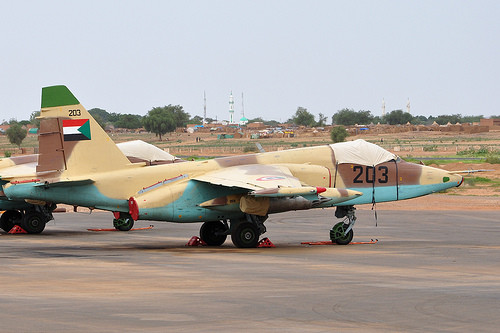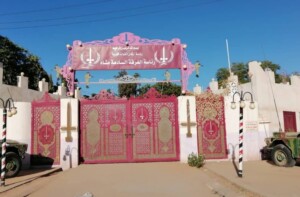Sudanese Air Force intensifies its air raids on RSF sites

A Sudanese Air Force fighter jet at the airport of El Geneina, West Darfur, May 2023 (File photo: Supplied)
The Sudanese Air Force recently intensified its bombardments on sites of the paramilitary Rapid Support Forces (RSF) in various cities, towns, and villages in the country. In the absence of official data from the army, Radio Dabanga verified reports about airstrikes on Saturday, August 31.
Ground battles between the Sudanese Armed Forces (SAF) and the paramilitary RSF have almost completely stopped after the RSF took control of large parts of Sennar two months ago. The two belligerents now continue their warfare with drones, heavy and light rocket launchers, and mortars to attack sites of the enemy. These ‘blind attacks’, however, cause a large number of deaths and wounded among civilians and the destruction of private and public property and government facilities.
The SAF, however, has a major advantage in combat power by air. The Sudanese Air Force uses fighterjets and helicopters, in addition to Antonov transport aeroplanes that drop incendiary barrel bombs on targeted areas, as it used to do in the war against rebel fighters in Darfur that broke out in 2003.
Although the SAF has lost many of its aircraft since war with thr RSF erupted in mid-April last year, it has strengthened its air strike capabilities in recent weeks. Warplanes have been carrying out daily raids, unprecedented since the beginning of the war, in various states controlled by the RSF.
Observers link the intensified bombardments to rumours about the army obtaining new aircraft. The rumours vary about the source of the new warplanes. Some point to Algeria, while others mention Egypt being the source of new aircraft – which prompted the spokesman for the SAF to officially deny that Egypt has supplied Chinese-made aircraft to the Sudanese Air Force. A third group, made up of army supporters, lauds Russia for its military assistance to the SAF. Some sources even say that the army hired foreign technicians and pilots to fly these warplanes.
In the absence of official data from the SAF about the air raids they are carrying out, Radio Dabanga monitored air attacks on Saturday, August 31, to verify the extent of the airstrikes.
On that day alone, warplanes launched airstrikes on Jabrat El Sheikh in North Kordofan, Zalingei in Central Darfur, Mellit and Fashshar in North Darfur, and Wad Madni in El Gezira.
While pro-army social media accounts spoke of heavy strikes on RSF sites, they did not mention the heavy toll of deaths and injuries among civilians, and the destruction of homes, private and public facilities.
Jabrat El Sheikh
Jabrat El Sheikh is located in North Kordofan, 160 km north of the state capital El Obeid. The town is part of a major corridor for the trade route that connects Omdurman, the sister-city of Khartoum, with Bara, a regional transportation hub about 30 kilometres north of El Obeid.
Warplanes launched an airstrike on the town on Saturday at 20:30. No casualties or injuries were recorded among the residents, but a number of homes and public facilities were damaged.
A listener told Radio Dabanga from Jabrat El Sheikh that two homes were hit. Several official institutions, including the offices of Jabrat El Sheikh locality, the courthouse and the police station in the northeastern part of the town were also targeted. The RSF use these buildings as headquarters for their forces,
The Dabanga verification team checked a video of the airstrike posted on Facebook and found it consistent with the source’s report.
Zalingei
At around 22:00 on Saturday, the Sudanese Air Force again targeted Zalingei, the capital of Central Darfur, that was seized by the RSF in end October last year following months of fighting with the SAF.
The bombing focused on the Khamsa Dagayeg camp for displaced people, the Karnak neighbourhood in the centre of the city, and an area nearby from the Zalingei Grand Market.
The airstrikes killed five people, wounded six others, and destroyed a number of homes, eyewitnesses reported. No RSF target in the city was hit.
A video clip posted on social media shows the blind Sheikh Matar Ali Hussein, a well-known a well-known community leader and a supervisor of the Darfur Displaced and Refugee Camps Coordination, confirming that the Khamsa Dagayeg camp was bombed at 10:15 pm.
North Darfur
Speaking to Radio Dabanga, a resident of Mellit reported that army warplanes carried out airstrikes on the town on Saturday, targeting several neighbourhoods and RSF sites with 15 bombs. At least 11 people were killed and nine others injured.
A 41-second video clip, which Dabanga’s verification team was able to trace to the southeastern edge of the town, showed images of smoke rising from a distant location beyond the residential areas. It is believed that the aircraft targeted the Mellit military garrison, located in the east of the town, and seized by the RSF in April.
Mellit later witnessed clashes between rival RSF commanders, which prompted the RSF leadership to send large groups of paramilitaries to the town to contain the violence. These forces operate from the former offices of the UNAMID mission and the Mellit locality buildings in the town, which explains the air strikes on the town centre.
Mellit, located about 65 km north of El Fasher, the capital of North Darfur, is considered a gateway to El Fasher from the north. It is also the last crossing point of the Ed Debba-El Fasher route, which the Geneva mediation last month succeeded in convincing the warring parties to open and safeguard the transport of humanitarian aid.
El Fasher has been a constant target of army aircraft since the RSF besieged the city in April. Airstrikes often attack RSF positions in the northern and eastern outskirts of the city. However, the recent incursion of the paramilitaries into the city’s neighbourhoods has led to the Sudanese Air Force targeting residential areas, including camps for the displaced.
On Saturday at exactly 10:00, warplanes launched an air raid on the village of Fashshar, 15 kilometers east of El Fasher, not far from the Fashshar Dam, which is considered one of the main water sources in the region.
A video released by the RSF, of which the authenticity could not be verified by the Dabanga verification team, shows that the raid killed two civilians and injured several others. The testimonies provided by residents in the area were recorded by members of the RSF. Nevertheless, the video shows the extent of the destruction that befell several houses in the village.
Wad Madani
On Saturday morning, warplanes launched an airstrike on the wholesale Es Soug El Markazi in the southern part of the Wad Madani, capital of El Gezira, that fell to the RSF in December last year.
A 2-minute and 51-second video, whose location was confirmed by Dabanga’s verification team, shows a number of RSF soldiers in Wad Madani immediately after the airstrike, threatening the Sudanese army.
But the video above all depicts the scale of the destruction in the area and the casualties among civilians, including street vendors, tea and coffee sellers on the main roads near the market.
The presence of large numbers of RSF paramilitaries in the area not only confirms that the air force targeted one of their larger bases, but also confirms that aerial bombardments do not differentiate between military and civilians in the targets located within residential areas, markets, and government and private facilities.
Calls for a no-fly zone
With the army intensifying its air raids against the RSF, which do not possess warplanes and rely on limited-effective air defence systems, civilians are paying a heavy price in the war.
Civil society and human rights organisations, and even a SAF-backing rebel movement have demanded that Sudanese airspace be considered a no-fly zone. However, it is unlikely, given the current international balances, that such a proposal will find its way to implementation.
Some are calling for instead resorting to UN Security Council resolutions regarding Darfur in the past, especially as Sudan’s western region is the one most exposed to airstrikes. The resolutions are still in effect and their implementation is subject to periodic review by the Council.











 and then
and then